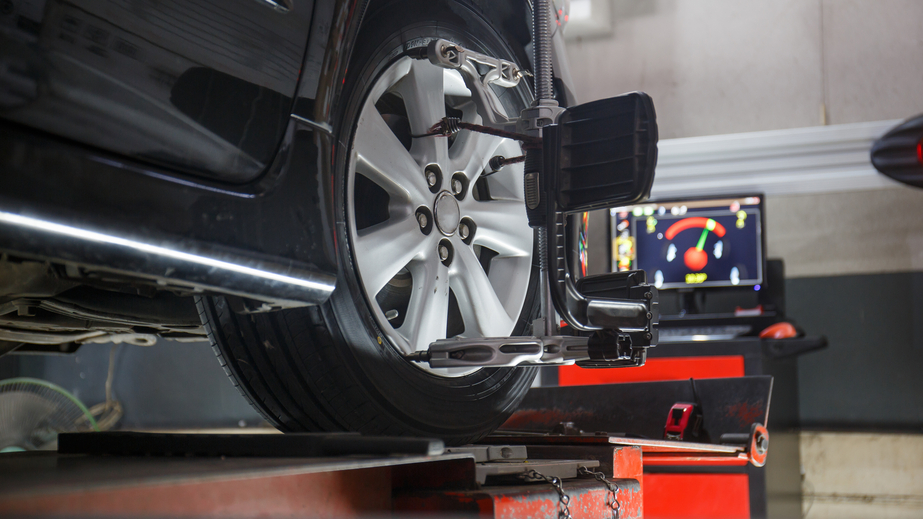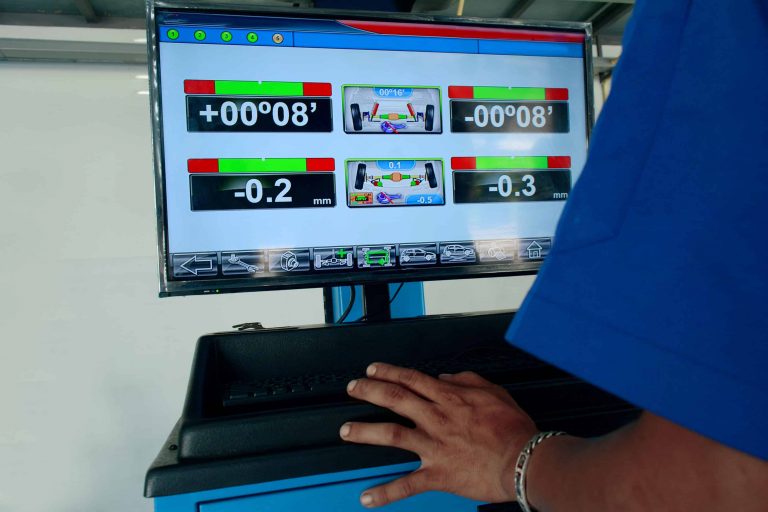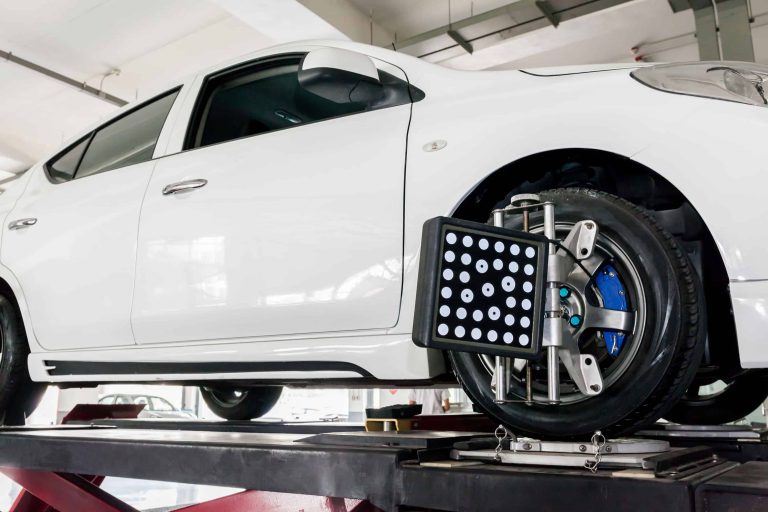 Car on stand with sensors on wheels for wheels alignment camber check-in workshop of Service station.
Car on stand with sensors on wheels for wheels alignment camber check-in workshop of Service station.
Do you ever find that your vehicle seems to veer, even slightly, to the left or to the right? If so, this could be the result of poor wheel alignment. This is both a simple yet urgently needed fix. Not only will an alignment make for a smoother and safer ride, but it will also extend the lifespan of your tires.
Front End Alignment vs. 4 Wheel Alignment

Along with “wheel alignment” you may have also heard of the term “front-end alignment”. Do these two things mean basically the same thing? For all intents and purposes, yes. Wheel alignment may refer to the alignment of all four wheels, especially in four-wheel-drive vehicles. Front end alignment only references the front two wheels. But no matter what you call it, getting your wheels aligned is something every vehicle owner should invest in from time to time.
Why Car Wheel Alignment Matters
When your car is first manufactured, the wheels are aligned, tested, adjusted and ultimately verified at the factory. In a brand new vehicle, there shouldn’t be any problem with a wheel alignment. But over time, most drivers will find that their wheels fall out of alignment.
Causes of a Bad Tire Alignment
There are various reasons for wheels or tires to fall out of alignment, most of which have to do with driving conditions. Driving down a poorly maintained road can cause wheels to become misaligned. Driving badly down these roads can make things worse. Hitting potholes and running into curbs can also affect your car alignment.
Car Alignment Symptoms
Wheel alignment issues may not be noticeable at first, but damage can still be occurring. When tires are even slightly out of alignment, it can accelerate uneven wear and tear on your tires. This means your tires won’t be performing as well as they should be, and you might have to spend money to have those tires replaced sooner than expected.
There are no warning lights or indicators for vehicle alignment issues, so the best ways to prevent premature tear, regular checkups are the best solution. What you might be able to notice, though, is a change in your car’s handling, such as the vehicle pulling to the left or right.
Other symptoms may include a vibrating steering wheel or noticing that it is off-center even though you’re driving straight. Any of these indicators should send you straight to a technician for an alignment check.
Benefits of Car Wheel Alignment

A tire alignment helps your vehicle in many ways, but ultimately it ensures optimal drivability. Not only does it extend the life of your tires, but it also helps your car drive smoother, and consume less energy, which usually translates into fuel savings.
Check out below the several benefits of having your wheels aligned regularly:
- Your tires will last longer;
- Your vehicle will drive smoother;
- Your wheels will point in the right direction, which means you can cruise without constantly correcting course;
- Your car will take less energy to keep going, which can save you money at the pump;
- Your car will handle better, which means it will be safer
Unfortunately, there is no definite way to tell when your tires are out of alignment until you take your vehicle to an auto care professional. If too much time passes and the misalignment becomes so bad that the car no longer drives in a straight line, considerable tire damage has already been done.
This is why it is best to have your vehicle inspected regularly. Make sure alignments are a part of your routine maintenance efforts. To learn more and get redirected here eastcoasttoyota.com take your vehicle on this professional service and inquire about how often you need to have an alignment.
FAQs:
Q: What’s the difference between 2 wheel alignment and 4 wheel alignment?
A: A 2-wheel alignment, also known as a front-end alignment, means the technician performs the service on only the front wheels, which may include a camber, toe, and caster adjustment. In some cases, a ‘thrust angle adjustment’ may be necessary, to ensure that all four wheels are ‘square’ with one another.
A 4-wheel alignment refers to adjusting all four wheels, which is typically required on all-wheel-drive models, with independent suspensions. This may include a front toe and caster adjustment, just like the front end alignment, while the rear wheels receive a toe and camber adjustment.
Q: How much does it cost to get an alignment?
A: Obviously, a 4 wheel alignment will be double the cost of a front end tire alignment. However, the process is straightforward, and the cost is not high at all, anywhere between $50 and $100, although most of the times, a tire rotation is needed as well, which adds to the cost.
Q: How do you know if you need a front end alignment?
A: There is no specific sign of wheel falling out of alignment, except for when too much damage has already been done. This is why it’s important to have an alignment check regularly.
Q: Is wheel alignment a necessary service?
A: Although it may not seem like an important issue, driving with misaligned wheels or tires for extended periods of time will lead to more extensive damage, which will ultimately cost you more and keep your car off the road for longer.
Q: How often should I have an alignment check?
A: There is no rule on how often you should check your wheel for alignment, and it’s independent of the type of vehicle you drive. However, if your usual driving conditions are poor, then you should have your vehicle alignment check more often. Other than that, the basic recommendation is every 2 or 3 years.
Q: How long does it take to have my wheel aligned?
A: This is a quick and clear service, and it takes on average about 1 hour. If supplemental work is needed, depending on the wear and tear, then additional time may be required.



Leave a Reply